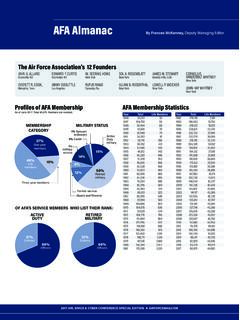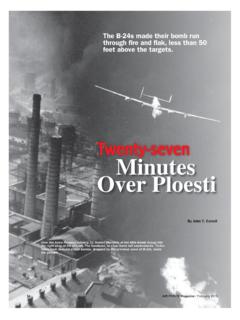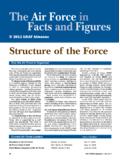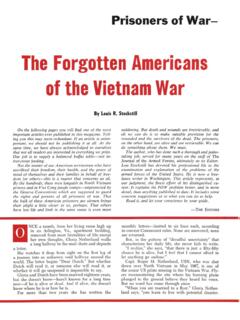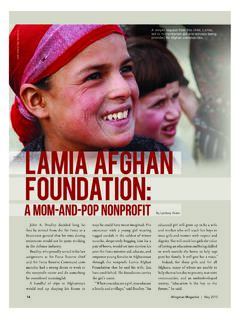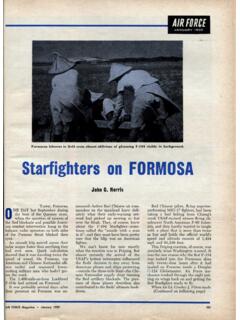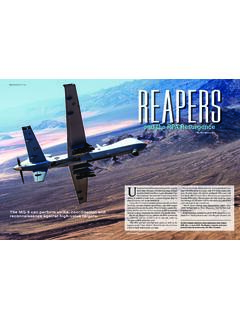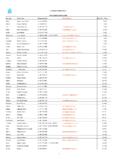Transcription of To the Top of Takur Gar - Air Force Magazine
1 To the Top of Takur GarTSgt. John chapman earned the Air Force Cross for his heroism in the mission to recover Navy SEAL Neil night was frigid as the MH-47E Chinook ap-proached Objective Ginger, a knife-like ridge that ran along the spine of an 11,000-foot moun-tain called Takur Gar. It was March 4, 2002, and the US military was heavily engaged in Opera-tion Anaconda, rooting out remnants of al Qaeda holed up in a series of cave complexes and bunkers lacing the hill-sides of the Shah-e-Kot Valley, in the eastern highlands of Afghanistan. The joint special operations reconnaissance and targeting team inside the helicopter knew Objective Ginger represented valu-able high ground with a commanding view of the entire Anaconda al Qaeda fighters secretly dug in atop Takur Gar knew it, the Chinook dubbed Razor 3 approached the snow-covered landing zone, Air Force TSgt.
2 John chapman , a combat controller, and the Navy SEAL (Sea, Air, Land) team he was accompany-ing felt a mixture of cold air and engine backwash pouring through the open rear By James KitfieldTAIR Force Magazine / July 201152door. Before the aircraft could touch down, machine gun fire erupted and the thud of impacts raked the fuselage. Then came an explosion and a sickening lurch as a rocket-propelled grenade scored a direct hit, severing hydraulic lines and severely damaging the helicopter. The pilots from the 160th Special Operations Aviation Regiment veered sharply away from the hot landing zone and struggled to get the aircraft back under control, scanning the terrain through night vision goggles as they searched for some place to bring the crippled helicopter down.
3 Even before they could land at an alternate site, the entire team realized that in the chaos and confusion, one of the SEAL team members Petty Officer 1st Class Neil C. Roberts had been knocked from the helicopter and had fallen into a hot landing zone under control of the enemy. Thus began a sequence of events that led to the deadliest military engagement in the war on terrorism up to that point, involving countless acts of heroism and, ultimately, the death of seven US troops. The special operators were soon on the ground after the aborted first run, having landed on a flat patch of hillside roughly four miles away. They were now faced with a mission that had crushing new urgency. chapman , deployed from the 24th Special Tactics Squadron out of Pope AFB, , immediately went to work.
4 He quickly estab-lished communication with an AC-130 gunship, direct-ing it to provide the team with close air support. He also had to determine how secure the immediate area was. These actions lim-ited the exposure of the aircrew and team to hos-tile fire, chapman s Air Force Cross citation reads. He also requested and co-ordinated a helicopter to extract the stranded team, and requested the AC-130 join an unmanned MQ-1 Predator already searching for Roberts. Informed that al Qaeda fighters had already cap-tured Roberts and taken him away, chapman and the SEAL team made a fateful decision. They decided on the spot to retrieve their fallen comrade Roberts. They were going back up to the top of Takur Gar. This choice at the impromptu land-ing zone was not out of the ordinary for the gung ho combat controller, but it would lead to his becoming one of only five enlisted airmen since Vietnam to earn the Air Force Cross, second only to the Medal of Honor in the recognition of extraordinary heroism in DecisionsJohn A.
5 chapman grew up in Wind-sor Locks, Conn., a small town of 12,000 situated on the Connecticut River. Early on, he showed the athleti-cism and nerve that would earn him All State in diving three out of his four years in high school, and make him a standout on the soccer team. To his tight-knit family and circle of friends, he seemed to personify the All-American Boy, a happy-go-lucky athlete with an easy smile and winning manner. After a short stint at the University of Connecticut, chapman enlisted in the Air Force in 1985 seeking adventure. When he didn t find enough of it work-ing in front of computers in the 1987th Information Systems Squadron, he volunteered for the elite combat control team (CCT) career field, beginning the grueling year-long combat controller Left: An Army map shows the moun-tainous terrain where the Battle of Roberts Ridge was fought.
6 Above: TSgt. John chapman and a Navy SEAL team went back to Takur Gar to retrieve a fallen Force Magazine / July 201153training program at Lackland AFB, Tex. He was not heard to complain about the lack of adventure in his life storied combat controller career field grew out of a disastrous mass airborne assault on the island of Sic-ily during World War II. Roughly 700 paratroopers were mistakenly dropped out at sea over the Mediterranean, and many of the aircraft involved nearly flew into each other. Given the obvious need for more accurate airdrops during airborne campaigns, the US Army cre-ated the Pathfinders, scouts and recon specialists who would find their way to an objective before the main assault forces and provide visual guidance, with flares, high-powered lights, and smoke pots, to inbound aircraft and jumpers.
7 When the Air Force became a separate service in 1947, the Pathfinders went with the air arm to provide the nascent service expertise in air traffic control and navigation for airborne operations. The Pathfinders were later renamed combat control AfghanistanMSgt. Ron Childress was an instruc-tor at the CCT school when chapman arrived. Generally, I tend to remember guys for one of two reasons: Either they are real good or real bad. John chapman was one of the real good ones, he said in an interview. I liked that he was a quiet, unassuming guy, but with that cocky at-titude that all good combat controllers have. We became good friends. Not even a gifted and committed ath-lete like chapman found CCT training easy. There was the highly technical Combat Control Operator Course in air traffic control, air navigation, and communication procedures.
8 There was a rigorous, weeks-long course at the Air Force Survival School at Fairchild AFB, Wash., where chapman and his classmates received instruction in how to survive on their own in harsh climates and conditions. At the Army s Airborne School at Fort Benning, Ga., chapman learned basic parachuting skills neces-sary for infiltration behind enemy lines. Pope s Combat Control School instruc-tors taught chapman and his teammates small unit tactics, fire support, demoli-tion, and land navigation. After initial training, combat control-lers go on to the graduate-level Special Tactics Advanced Skills Training, which includes training in free fall parachuting at the Army Military Free Fall Parachut-ist School at Fort Bragg, , as well as the Air Force Combat Dive Course, taught at the Naval Diving and Salvage Training Center in Panama City, Fla.
9 To earn the signature red beret of an Air Force combat controller, chapman had to complete one of the most rigor-ous training regimes in the entire US military. Each combat controller is an airpower-savvy commando who can run, jump, or swim with members of any other special operations unit and act as their conduit for close air support, air insertion and extraction, and other airpower functions. I remember putting some combat controllers through some tough scuba training, and an observer asked me, What are you trying to do, train them to be SEALs? Childress said. And my answer was, no, I m training them so that they don t slow the SEALs down. chapman persevered through this extraordinarily difficult training course, becoming one of only seven members of his training class to graduate into combat control.
10 Besides mastering skills such as establishing aircraft landing zones and parachute drop zones and calling in ordnance from ground-attack aircraft, chapman ultimately became chapman in Afghanistan. John Chap-man s father said that his son knew the career path he had chosen was a danger-ous photoAIR Force Magazine / July 201154a military free fall parachutist, a static line jumpmaster, and a military scuba dive supervisor. John loved his job. We all did, because no combat controller thinks he actually works for a living, said Childress, speaking of the adventure and camaraderie that goes with the combat control badge and motto, First There. For John and me and all other combat controllers, the coolest part of the job is you can watch Fox News and know where you re going to be sent tomor-row, Childress said.
